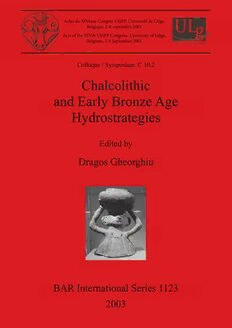
Chalcolithic and Early Bronze Age Hydrostrategies PDF
93 Pages·2003·15.968 MB·English
Most books are stored in the elastic cloud where traffic is expensive. For this reason, we have a limit on daily download.
Preview Chalcolithic and Early Bronze Age Hydrostrategies
Description:
The main emphasis of this book is water and its importance in prehistoric societies, and it looks at how people in the period from the Chalcolithic to the Early Bronze Age exploited water in various ways. This ranges from the large scale utilisation of water for agricultural purposes, down to the design of bowls, materials and decorative figures. The study gives a broad outline of the cultural and physical impact of water upon societies during this period, and goes so far as to define water as a central element for the study of ancient societies. The argument is that as civilisation progressed out of the Neolithic, people gained a better control of wetlands and were able to colonise river valleys and drain marshes. The study begins by investigating the Neolithic in Mesopotamia and the Chalcolithic in the Balkans, stating how society had gained a developed management of water on different levels, and this is indicated by the design of settlements, houses and objects. The importance of water as a major influence over settlement patterns is shown in terms of water as a resource, but also as a means of communication and as a defensive barrier. Technological improvements relating to the collection, movement, storage, and usage of water are investigated in depth. These advances offered man a greater level of control over his environment, and allowed the control of seasonal flooding in the Near East, and more intensive agriculture in Temperate areas of Europe. Water trade routes from the Neolithic were still used in the Chalcolithic and the Bronze Age, but many other trade routes grew up as shipbuilding developed, with the cultures of Greece and Mesopotamia becoming seafarers. The study of certain objects such as figurines and temple offerings show that cultures considered the collection and storage of water to have a great importance, and attached ritual values to these practices. Often, owing to the importance of water in their lives, people would worship the springs and other water sources associated with their settlements. Some of the papers in this study infer that these primitive religions were based upon the fertility values of water in their society. For instance, in the Balkans many container vessels are in the shape of the female body, linking these to a fertility cult of water. However the main theme of this book is to look at the archaeology of water exploitation strategies, both on the macro and the micro-level.
See more
The list of books you might like
Most books are stored in the elastic cloud where traffic is expensive. For this reason, we have a limit on daily download.
